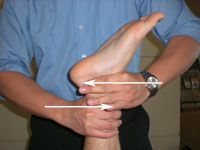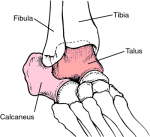The term mobility has become a popular topic over the past few years, and for good reason. Long before I took my first anatomy course I was under the assumption that if I was “tight” (a.k.a. lacking ROM) in a specific direction that I should stretch the musculature responsible for the deficit. While this is not incorrect, it is often times only part of the equation–especially for people who assume static or restricted positions for long periods of time. An area that is susceptible to ROM deficits is the ankle, and more specifically decreased dorsiflexion (bringing your toes to your shin). Examples of this population include but are not limited to students and office workers who sit at a desk during the day, athletes who wear a restrictive boot during their sport (hockey players, skiers, etc.), and anyone whose profession keeps them in a plantarflexed or neutral position.
While we know that muscle tissue will adaptively lose viscoelastic properties when maintained in a short position; we often forget that inert or non-contractile structures, most notably the joint capsule will do the same. Therefore, if we have assessed that the dorsiflexion (DF) deficit is secondary to tight inert structures and not musculature, joint mobilization can be very helpful.
When deciding to use joint mobilization as an intervention, the principle of arthrokinematics of the ankle must be considered. I wrote extensively on this topic in an earlier post. To review please select the link https://lukedelorenzo.wordpress.com/2011/07/27/arthrokinematics-an-important-biomechanical-concept/.
To summarize, select the joint you wish to mobilize, figure out which articulating surface is concave and which is convex, observe which surface is moving and which is fixed, and finally, facilitate glide of the moving structure OR stabilize the fixed structure. Previously, I have suggested than during a closed chain movement of DF at the Talocrural Joint (TCJ), the tibia should be facilitated to glide anteriorly based on the biomechanical principles of the tibia rolling and gliding in the same direction on a fixed talus. When I suggested this to my friend, he noticed that he was getting a small amount of impingement in his anterior ankle. I started to experiment and came up with a way to stabilize the talus while moving the tibia.
Without getting too detailed, if the posterior capsule of the TCJ is tight, the talus will ride forward with the tibia during DF, thereby limiting the ROM and causing the heel to lift off of the ground. In my example, using a strap to stabilize the talus should facilitate DF without giving a sensation of impingement, and subsequently giving a stretch to the gastroc-soleus complex.
In the video below, I show a visual example. I drew a line under my medial malleolus (ankle bone) to emphasize where the strap should be placed. Based on the orientation of the joint, if you place the strap over the ankle bone the talus will not be stabilized. Please see the photo below to get a better idea.
Here is how to perform the technique:
1. Place bench directly in front of a bar with the surface of the bench higher than the bar
2. Place strap in appropriate position under malleoli
3. Anchor strap to bar to minimize anterior talar migration
4. Perform a lunging motion bringing the shin forward over the toes
Please select the link below to view the video and hopefully you find the exercise helpful!


